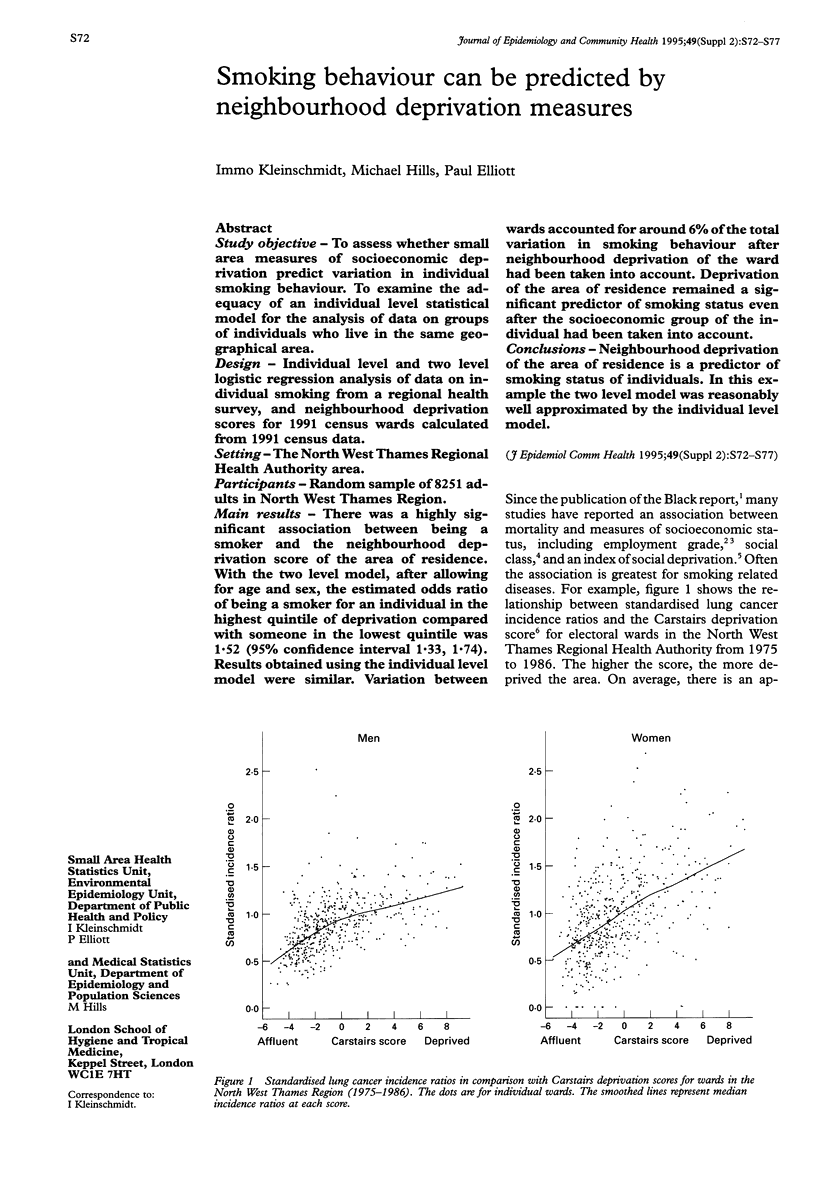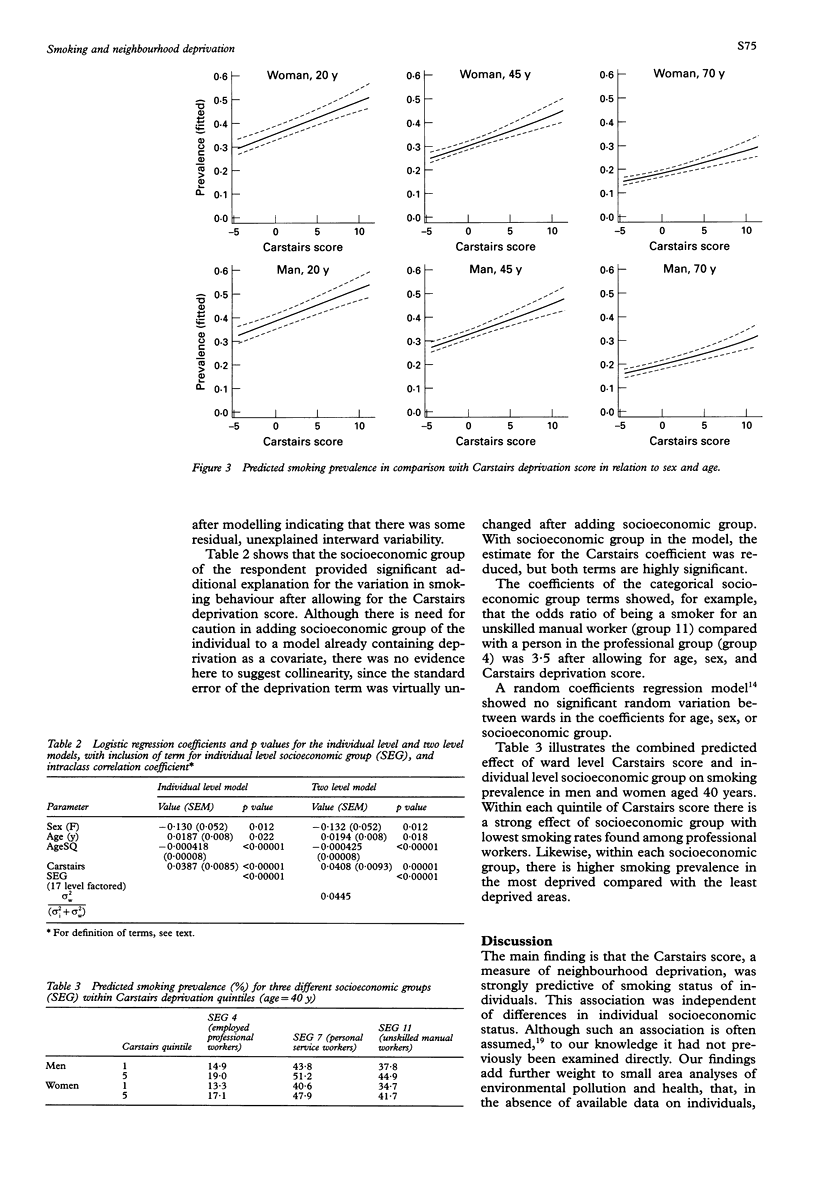Abstract
STUDY OBJECTIVE--To assess whether small area measures of socioeconomic deprivation predict variation in individual smoking behaviour. To examine the adequacy of an individual level statistical model for the analysis of data on groups of individuals who live in the same geographical area. DESIGN--Individual level and two level logistic regression analysis of data on individual smoking from a regional health survey, and neighbourhood deprivation scores for 1991 census wards calculated from 1991 census data. SETTING--The North West Thames Regional Health Authority area. PARTICIPANTS--Random sample of 8,251 adults in North West Thames Regions. MAIN RESULTS--There was a highly significant association between being a smoker and the neighbourhood deprivation score of the area of residence. With the two level model, after allowing for age and sex, the estimated odds ratio of being a smoker for an individual in the highest quintile of deprivation compared with someone in the lowest quintile was 1.52 (95% confidence interval 1.33, 1.74). Results obtained using the individual level model were similar. Variation between wards accounted for around 6% of the total variation in smoking behaviour after neighbourhood deprivation of the ward had been taken into account. Deprivation of the area of residence remained a significant predictor of smoking status even after the socioeconomic group of the individual has been taken into account. CONCLUSIONS--Neighbourhood deprivation of the area of residence is a predictor of smoking status of individuals. In this example the two level model was reasonably well approximated by the individual level model.
Full text
PDF





Images in this article
Selected References
These references are in PubMed. This may not be the complete list of references from this article.
- Blane D., Smith G. D., Bartley M. Social class differences in years of potential life lost: size, trends, and principal causes. BMJ. 1990 Sep 1;301(6749):429–432. doi: 10.1136/bmj.301.6749.429. [DOI] [PMC free article] [PubMed] [Google Scholar]
- Curtis S. E. Use of survey data and small area statistics to assess the link between individual morbidity and neighbourhood deprivation. J Epidemiol Community Health. 1990 Mar;44(1):62–68. doi: 10.1136/jech.44.1.62. [DOI] [PMC free article] [PubMed] [Google Scholar]
- Doll R., Peto R. Mortality in relation to smoking: 20 years' observations on male British doctors. Br Med J. 1976 Dec 25;2(6051):1525–1536. doi: 10.1136/bmj.2.6051.1525. [DOI] [PMC free article] [PubMed] [Google Scholar]
- Doll R., Peto R., Wheatley K., Gray R., Sutherland I. Mortality in relation to smoking: 40 years' observations on male British doctors. BMJ. 1994 Oct 8;309(6959):901–911. doi: 10.1136/bmj.309.6959.901. [DOI] [PMC free article] [PubMed] [Google Scholar]
- Eames M., Ben-Shlomo Y., Marmot M. G. Social deprivation and premature mortality: regional comparison across England. BMJ. 1993 Oct 30;307(6912):1097–1102. doi: 10.1136/bmj.307.6912.1097. [DOI] [PMC free article] [PubMed] [Google Scholar]
- Elliott P., Hills M., Beresford J., Kleinschmidt I., Jolley D., Pattenden S., Rodrigues L., Westlake A., Rose G. Incidence of cancers of the larynx and lung near incinerators of waste solvents and oils in Great Britain. Lancet. 1992 Apr 4;339(8797):854–858. doi: 10.1016/0140-6736(92)90290-j. [DOI] [PubMed] [Google Scholar]
- Jarman B. Identification of underprivileged areas. Br Med J (Clin Res Ed) 1983 May 28;286(6379):1705–1709. doi: 10.1136/bmj.286.6379.1705. [DOI] [PMC free article] [PubMed] [Google Scholar]
- Jessop E. G. Individual morbidity and neighbourhood deprivation in a non-metropolitan area. J Epidemiol Community Health. 1992 Oct;46(5):543–546. doi: 10.1136/jech.46.5.543. [DOI] [PMC free article] [PubMed] [Google Scholar]
- Katz J., Carey V. J., Zeger S. L., Sommer A. Estimation of design effects and diarrhea clustering within households and villages. Am J Epidemiol. 1993 Dec 1;138(11):994–1006. doi: 10.1093/oxfordjournals.aje.a116820. [DOI] [PubMed] [Google Scholar]
- Macera C. A., Jackson K. L., Davis D. R., Kronenfeld J. J., Blair S. N. Patterns of non-response to a mail survey. J Clin Epidemiol. 1990;43(12):1427–1430. doi: 10.1016/0895-4356(90)90112-3. [DOI] [PubMed] [Google Scholar]
- Rose G., Marmot M. G. Social class and coronary heart disease. Br Heart J. 1981 Jan;45(1):13–19. doi: 10.1136/hrt.45.1.13. [DOI] [PMC free article] [PubMed] [Google Scholar]
- Smith G. D., Shipley M. J. Confounding of occupation and smoking: its magnitude and consequences. Soc Sci Med. 1991;32(11):1297–1300. doi: 10.1016/0277-9536(91)90046-f. [DOI] [PubMed] [Google Scholar]
- Smith G. D., Shipley M. J., Rose G. Magnitude and causes of socioeconomic differentials in mortality: further evidence from the Whitehall Study. J Epidemiol Community Health. 1990 Dec;44(4):265–270. doi: 10.1136/jech.44.4.265. [DOI] [PMC free article] [PubMed] [Google Scholar]
- Walter S. D. A simple test for spatial pattern in regional health data. Stat Med. 1994 May 30;13(10):1037–1044. doi: 10.1002/sim.4780131006. [DOI] [PubMed] [Google Scholar]



